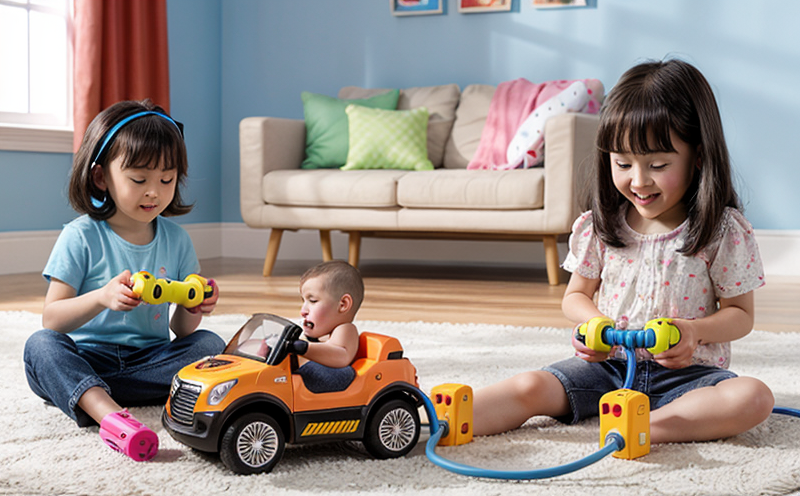IEC 62115 Toy LED Light and Laser Safety Testing
The International Electrotechnical Commission (IEC) standard IEC 62115 is a globally recognized guideline for ensuring the safety of toys that incorporate LED lights or laser components. This standard is particularly crucial in today’s toy industry, where technological advancements have introduced new risks associated with light and laser emissions.
The primary goal of this testing procedure is to ensure that toys do not pose any hazards when exposed to children. The standard covers a wide range of tests aimed at detecting potential risks from LED lights and lasers in toys. These risks include but are not limited to burns, eye injuries, and other forms of harm.
IEC 62115 is designed for toys intended for use by children up to the age of 14 years old. This includes a variety of products such as mobile phone accessories, remote controls, and any other toy that might incorporate LED lights or laser components. The standard provides detailed guidelines on how to test these toys comprehensively.
Compliance with this standard is essential for manufacturers looking to meet international safety regulations. It ensures that the toys they produce do not expose children to harmful levels of light and laser emissions, thereby protecting public health and safety.
The testing process involves several steps designed to simulate real-world conditions in which a child might interact with the toy. This includes exposure to different types of environments, including direct sunlight and indoor lighting conditions. The tests are rigorous and cover various scenarios that could potentially lead to harm.
During the testing process, the following key parameters are typically evaluated:
- The intensity of light emitted by LED lights
- The wavelength distribution of the emitted light
- The duration and pattern of laser emissions
- The proximity and angle at which the toy is held relative to the child’s eyes
Sample preparation involves ensuring that the toy is in its intended condition for testing. This includes charging batteries, setting up remote controls, or preparing any other necessary components before the test begins.
The instrumentation used for this type of testing must be precise and capable of accurately measuring the emitted light and laser levels. This often requires specialized equipment such as photometers, spectrometers, and laser meters. The data collected from these instruments is then analyzed to ensure compliance with IEC 62115.
The report generated from this testing process provides detailed information on the toy’s performance against the standard. It includes a comprehensive breakdown of all test results, along with recommendations for any necessary modifications or improvements.
By adhering to these rigorous standards and tests, manufacturers can ensure that their products are safe for children, thereby protecting public health and complying with international regulations.
Why Choose This Test
Selecting IEC 62115 Toy LED Light and Laser Safety Testing is essential for several reasons:
- Ensures Compliance with International Standards: This test aligns your product with global safety standards, ensuring that it meets the requirements set by regulatory bodies.
- Risk Mitigation: By identifying potential hazards early in the development process, you can mitigate risks and avoid costly recalls or legal issues.
- Enhanced Product Reputation: Demonstrating compliance with these stringent standards enhances your brand's reputation as a leader in safety-conscious manufacturing.
The testing ensures that any toy incorporating LED lights or laser components is safe for children, thereby protecting public health and complying with international regulations. This not only reduces the risk of accidents but also fosters trust between consumers and manufacturers.
Moreover, this test provides you with valuable insights into your product’s performance, allowing for continuous improvement and innovation in future iterations.
Quality and Reliability Assurance
The quality and reliability of the testing process are paramount to ensuring that toys meet stringent safety standards. Here’s how we ensure these aspects:
- Precision Instruments: Our laboratory uses cutting-edge equipment like photometers, spectrometers, and laser meters for accurate measurements.
- Standardized Procedures: Every test follows a strict set of guidelines to ensure consistency and repeatability.
- Expertise: Our team comprises highly skilled professionals with extensive experience in toy testing and safety standards.
The precision instruments used are calibrated regularly to maintain accuracy. This is crucial for obtaining reliable results that can be trusted by manufacturers, regulatory bodies, and consumers alike.
Standardized procedures ensure that every test conducted follows the same steps, reducing variability in outcomes. This consistency allows us to provide repeatable results, which is essential for quality assurance.
The expertise of our team means they are well-versed in interpreting the latest standards and guidelines, ensuring compliance even as regulations evolve.
International Acceptance and Recognition
- Global Standard: IEC 62115 is an international standard recognized by countries across the globe, ensuring that your product meets a wide range of requirements.
- Regulatory Compliance: Many countries mandate compliance with this standard to ensure toy safety. By adhering to it, you meet these regulatory requirements easily.
The widespread acceptance of IEC 62115 means that your product can be sold in multiple markets without the need for additional testing or certification processes. This not only saves time but also reduces costs associated with compliance.
Moreover, international recognition enhances your brand’s reputation as a leader in safety-conscious manufacturing, fostering trust and loyalty among consumers worldwide.





